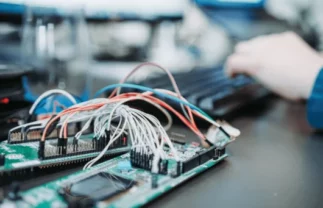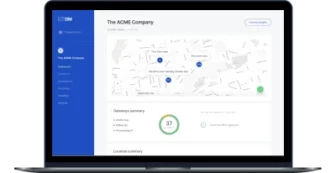In large-scale manufacturing, downtime can be outright disastrous. Business owners invest millions in expensive equipment and instruments, and each second these assets are not working towards cost recovery is a second of losses. These losses aren’t limited to the cost of unperformed work or repairs and can significantly harm the company’s overall performance.
Improving the maintenance routine, therefore, plays a major role in any production enterprise’s activity. This article is designed as a guide to IoT-based predictive maintenance implementation that would serve as a major improvement for many companies. In this article, we share our knoweledge and expert opinion since we create custom IoT software solutions for manufacturing companies.


Types of maintenance and their effectiveness
Let’s take a look at the main ways manufacturers deal with failing and broken equipment.
Reactive maintenance
This type of maintenance is the most basic and traditional. Basically, reactive maintenance by definition works on the principle of fixing something when it breaks. Despite its global use, this kind of maintenance can be really harmful to your business.

- Government sanctions. If your manufacturing business is associated with risks of environmental pollution, risks to health, or other significant possible threats to society, most governments will react harshly to any safety violations. A malfunctioning water filtering system may lead to huge fines, and problems with equipment in a pharmaceuticals production facility can cost you your drug manufacturing license.
- Loss of partners. Your affiliates expect you to be reliable and fulfill your obligations on schedule. They might be understanding and patient if you fail to do so once. Then again, they might not be.
- Global reputational losses. The business world tends not to tolerate nonperformance. Any decision to work with another enterprise is influenced by that enterprise’s business history. A history of equipment malfunctions leading to downtime diminishes a company’s chances of successful collaboration.
The Visakhapatnam gas leak incident perfectly illustrates the dangers of reactive maintenance. In May 2020, a chemical plant located near Visakhapatnam, India, belonging to LG Polymers, had a major gas leak. The results were disastrous for the local population: 11 dead and over 1000 sick after exposure to the gas, over 20,000 evacuated, and the drinking water supply of the region disrupted.
LG Polymers, of course, took a heavy legal and financial hit: 12 personnel arrested, including the managing director, CEO, and technical director, and over $7 million in fines as an initial amount to mitigate the damage.
All of this could have been avoided if LG Polymers’ gas tanks had temperature sensors connected to an IoT network.
The dangers of reactive maintenance exist regardless of the speed and efficiency of repairs. Reacting to downtime caused by malfunctions is not enough if a company strives to maximize its efficiency.
Preventive maintenance
Preventive maintenance (or IoT preventative maintenance) is better than reactive. It is focused on performing periodic scheduled maintenance. The idea here is that the time interval between maintenance sessions will be short enough to prevent most possible equipment problems. However, preventive maintenance is not flexible enough to be completely reliable: some problems arise quite suddenly and may happen long before the next scheduled maintenance session.
Besides, unnecessary spending of time and other resources on maintenance when problems are absent is not ideal.
IoT condition based maintenance
This type of maintenance requires the use of sensors that send signals to the operator when equipment reaches a certain level of degradation. Despite being a precursor of predictive maintenance (PM), condition-based maintenance has one serious drawback: it is not very precise. With condition-based maintenance, operators tend to get notifications only when equipment is already in noticeable need of repair.
Predictive maintenance
Finally, IoT-based predictive maintenance relies on complex technologies to detect the earliest signs of a potential problem. Multiple sensors combined with devices for receiving and analyzing their signals detect numerous parameters of manufacturing equipment and send reports to the operator.
This is where IoT-based predictive maintenance (IoT PM) comes into play.
Predictive maintenance IoT solutions allow you to be proactive about any possible malfunctions in your equipment and inventory by gathering data about its functioning, processing and analyzing this data with algorithms built into the IoT PM system, and presenting it in a clear and comprehensible way.
Using IoT-based predictive maintenance allows you to see any potential problems with equipment and act preemptively, therefore completely avoiding most malfunctions and breakages. This kind of maintenance prevents massive monetary, reputational, and legal losses, which is completely unimaginable with the more traditional “repair it when it breaks” approach.
Who would benefit the most from implementing predictive maintenance IoT?
IoT PM can be used in a wide variety of factory and production environments due to the great flexibility of choices for system components. IoT PM sensors can measure temperature, humidity, proximity, fluid levels, and a ton of other criteria, making IoT PM applicable to most, if not all, manufacturing equipment.
Large manufacturing enterprises would experience the most prominent effect from the implementation of IoT PM. Benefits of IoT-based predictive maintenance are especially easy to see when the scale of production includes multiple large factories with tens or hundreds of items of equipment to manage.
Reactive maintenance or manual preventive maintenance will inevitably produce a large number of mistakes due to human factors, and with IoT PM, most of them can easily be avoided.
Reality shows that major industry players understand this: the IoT PM market has grown from $1.5 billion to $6.5 billion since 2016 and is expected to grow to $28 billion by 2026. The number of hardware and software vendors grows constantly, and industry leaders keep implementing predictive maintenance in their factories. IoT PM systems are used by IBM, SAP, Siemens, Microsoft, CISCO, Huawei, and many others.
A real-life IoT-based predictive maintenance case study of how a manufacturer can benefit from IoT PM
A suitable use case to illustrate the usefulness of implementing IoT PM is Tenaris, the leading manufacturer of pipes and related equipment and services for the energy industry. Tenaris is a big-time enterprise, employing more than 19,000 people in over 24 countries and with annual net sales amounting to $5.1 billion.
Tenaris has numerous factories, with thousands of pieces of heavy-duty equipment working in pipe production lines and on other activities daily. The number of potential failures and breakages in such conditions would be high regardless of the staff’s professionalism given the sheer scale of the operation. The company required a way to cut losses associated with such breakages and minimize the need to hire additional maintenance personnel.
To do this, they’ve decided to implement IoT PM in their facilities. One such facility, a factory in Dalmine, Italy, produces over 800,000 tons of products (gas and oil pipes as well as parts for industrial machines and cars) a year, runs round the clock, and serves as the Tenaris headquarters in Italy. Such an expansive enterprise required broad upgrade measures: 290 low-voltage motors and 20 high-voltage motors for running the equipment received IoT PM sensors that instantly detect failures in bearings, voltage and power, and many other areas.
Right from the start, these IoT PM techniques proved useful by detecting several anomalies in motor functioning. In particular, one sensor gathered and transmitted data showing that a motor’s water pump was in a dangerous condition and would fail soon. This allowed the Tenaris maintenance team to preemptively deal with the problem and ensure the facility’s stable and uninterrupted operation.
Having viewed the benefits IoT PM brings to manufacturing businesses, let’s grasp the main principles of IoT systems.
What is IoT and how does it help to ensure predictive maintenance of manufacturing equipment?
The Internet of Things is a system of devices connected via a network. In this system, each device has its own ID as well as the ability to transmit and receive information and interact with each other without direct human interaction or management.
IoT is applicable in many spheres, from smart homes to precision farming. In this article, we focus specifically on IoT-based predictive maintenance. If you want to learn more about IoT network management, read our article on this subject.
How are IoT PM systems organized?

The system begins at the field level, with industrial equipment fitted with PM sensors. There is a great variety of sensors, each measuring some criterion of the equipment and sending collected data to an aggregator called the gateway. Often, more than one sensor is needed to cover all possibilities of equipment failure.
For example, adding a water-cooled motor to the IoT PM system would require at least:
- one level sensor to measure the liquid level in the pumps
- one vibration sensor to detect anomalies in the bearing system
- one power sensor to detect voltage issues
The next stage is data aggregation in gateways. Gateways perform two main functions:
- Gathering and processing raw data from sensors
- Transferring processed data to monitoring devices and/or cloud storage
While sensors are purely data gathering devices with strictly limited functionality, gateways are more complex and make possible certain reverse connectivity options and remote tuning. This is made possible by implementing cloud application connectivity used for remote control and monitoring; we will talk about this later in more detail.
The most basic system required for local IoT PM is complete at this stage:
- Sensors gather information.
- Gateways process that information and send it to monitoring devices in a comprehensive format.
- Information can be analyzed and your maintenance staff can fix all issues manually.
This, however, is not the limit of the possibilities for IoT-based predictive maintenance. Undertaking cloud migration will allow you to connect your on-premises devices (sensors and gateways) to a web platform with a specialized web application. This can open a lot of additional options for remote control and data analysis.
Read also: How to enable industrial IoT data management and analytics
IoT PM web application
A comprehensive web application is a flexible and comfortable way to control your IoT predictive maintenance system. It might not be suitable for everyone because of the costs associated with its implementation, but big manufacturers and global companies will surely appreciate the level of comfort and simplicity such an application provides.
The more factories and equipment a company or service provider needs to manage, the more benefits an IoT predictive maintenance web application brings.
On the most basic level, a web application can provide the following features:
- Data aggregation. The vast amount of raw information from sensors first gets processed by gateways and then is sent to cloud storage that can be managed within the application. The storage can also potentially be connected to big data warehouses equipped with machine learning algorithms, allowing for the continuous improvement and updating of the application.
- Illustration of trends. Equipment malfunctions are rarely unrelated to the production process on-site. Failures tend to be the result of a long chain of events and interconnected factors. An IoT PM application can automatically create charts and tables illustrating statistics gathered from sensors and also highlight trends in malfunctions, revealing the true nature of problems on-site.
- Report creation. Processed and analyzed data gathered from gateways can then be organized into reports. Reports should be structured in a user-friendly fashion to increase readability and minimize the time it takes the operator to respond.
- Alerts. All dangerous signals and potential harmful tendencies should be discovered and highlighted comprehensively and clearly, then sent to the application user.
On a deeper level, all application functionalities can be divided into two large categories: processing incoming information and remotely controlling the IoT system settings. They can be implemented fully or partially, following the needs of the manufacturer.
Processing of incoming information
An IoT PM web application makes processing information much easier compared to manually handling all incoming data. You can access a web application anywhere and anytime if you have a device connected to the internet and a web browser. The options it can offer to a user include the following:
Factory and individual IoT network management
Most companies that would require an IoT-based predictive maintenance application are large multi-location enterprises. Therefore, features for local IoT network management and factory management are vital. Basic functionality will include:
- adding and removing factories and local networks
- editing a factory’s details
- reviewing the full list of equipment assigned to factories and local networks
Equipment management
Since IoT equipment maintenance is the focus of the whole IoT PM system, this system should provide extensive equipment management options to the user:
- Onboarding and assigning IoT equipment to create structured networks and measurement systems
- Setting up data gathering rules and filters to simplify preprocessing and optimize sensor functioning
- Pre-setting IoT equipment configurations both individually and in bulk for related IoT devices
- Reviewing and analyzing IoT device inventory
A web application also has huge potential for future add-ons. Depending on the company’s needs, new features might be considered such as advanced equipment system builders including drag-and-drop and graphics tools, automated system analyzers and balancers, scheme libraries, and recommendation engines.
Individual IoT network monitoring and analysis
One level up from equipment management, analysis, and monitoring of data received from local IoT networks is vital for mapping the current state of a business. Some issues and failures we associate with particular equipment might be the result of a more global problem arising from location issues such as bad water quality, for example. Only thorough local network monitoring can ensure the discovery of failure trends and, therefore, factory-level problems.
Features included in individual IoT network real-time monitoring and analysis:
- Reviewing channel-aggregated trends. Algorithms review information gathered from data channels through gateways, discover noticeable trends, and highlight them.
- Data baselining and anomaly detection. Users can manually set an acceptable range for metrics such as temperature or vibration so that the sensor will trigger a reaction when the metric goes outside that range, or they can let the system go through a tuning period and set range automatically.
- Historical/retrospective data analysis. Historical data is saved in cloud storage and is available for comparison and analytics.
- Interactive dashboard. This is a convenient interface tool providing information about the system.
Management of alarms and indicators
When information is analyzed and trends are identified by the IoT PM web application, the most important and urgent messages must be delivered to the user as fast as possible. Therefore, the web application should provide several features:
- Indicator settings. The web application should include a flexible set of tools for setting and/or fine-tuning emergency indicators, degradation indicators, sensor recalibration indicators, and any other indicators. Users should get information from this system in the form of notifications, warnings, or alarms. Whether it is a simple rule-based system or a complex AI system, users should have a comprehensive overview of it and reasonable adjustment tools.
- Notification settings. The web application should include a flexible set of notification/alarm delivery configurations created with user permissions, security, reliability, and the user experience in mind. These can be as simple as email settings or as fancy as a multi-platform notification ecosystem including mobile apps.
- Log system. A searchable log system should efficiently store all notifications, enabling actionable analysis.
Report management
A coherent format of incoming reports is crucial for getting a clear picture of a company’s equipment situation. An IoT PM web application can support the following features and more:
- Standard overview reports generated based on hard-coded rules (depending on industry-relevant scenarios)
- Advanced reports covering analysis of historical data and cross-comparisons of various data channels, periods, and trends to provide industry-relevant insights such as cost optimization or energy efficiency
- Custom report builders allowing users to aggregate specific data and analyze specific scenarios
- Searchable library of reports allowing users to optimize data processing engine loading
Besides the wide scope of information processing features, the app we’re describing should also provide remote control capabilities.
Remote control
While the web application format may lead to some really big and innovative ideas for remotely controlling the IoT PM system, the actual scope of such ideas is strongly limited by equipment capabilities. For instance, most sensors are primitive devices that can only communicate with gateways in a one-way fashion. Creating any kind of software that will be able to change sensor settings remotely or recalibrate sensors via gateways is not possible due to the specifics of gateway architecture.
Therefore, remote control options for IoT PM are usually limited to managing gateways and checking the connection quality. Some features that remote application control makes possible include:
- Upgrading a gateway’s firmware
- Changing a gateway’s settings
- Testing hardware sustainability
- Testing connection quality through the IoT PM system and troubleshooting potential connectivity issues
We are currently working on a project called WisDM. This device management platform helps to remotely control IoT network settings.

Future of IoT predictive maintenance
Technological progress, including the development of IoT technologies, is increasing in tempo every year. For example, the total number of connected IoT devices in the world grew from 30.73 billion to 35.82 billion between 2020 and 2021 according to Statista. Predictive maintenance global usage has grown similarly.
Widening 5G network coverage makes IoT PM implementation even more accessible for remote locations and equipment on fast moving objects like cars and trains.
In one of their latest reports on connected cars, Ericsson presented their view on the most significant factors for car manufacturers in the near future, and the development of car predictive maintenance systems is among them. Considering the sheer scale of the automotive industry, it is highly likely that IoT PM hardware and software manufacturers will have another booming market on their hands.
Digital twins
Another path that the predictive maintenance market might find advantageous to follow is the continuous improvement and implementation of digital twin technology.
Digital twin technology is about recreating a physical object (such as a piece of industrial equipment, or, in more complex cases, a whole factory) in a digital form. There are obvious drawbacks associated with such an approach, such as the inability to completely transfer all physical traits and possible characteristics of an object into digits (“the map is not the territory”) as well as various conditions and events occurring on-site. However, the advantages are just too prominent to ignore:
- Immensely increased speed of information analysis. With the digital object available, your algorithms can produce a thorough condition analysis in a fraction of a second as well as create numerous suggestions for a response.
- Testing possibilities. With a digital copy, possibilities for test simulations are practically endless. You can simulate any kind of on-site situation, apply it to your digital twin, and receive a detailed report on predicted outcomes. Waiting for a major deluge to see what kind of impact it will have on your water processing plant might take a long time, but with a digital twin, you can test such an occurrence fast and completely without harm to your equipment.

Conclusion
Large manufacturers need predictive maintenance strategy, and they know it. The demand for more and more complex and comprehensive IoT PM solutions will only grow in the foreseeable future, and being at the forefront of hardware and software development is paramount for IoT PM solution providers.
Cloud migration and subsequent implementation of a web application are currently one of the most efficient ways to manage large IoT PM systems that would otherwise require too much manual setup and might get bogged down due to human factors. If you want to learn more about the cloud migration process, read our article on the top reasons to migrate to the cloud.
For those vendors who strive to provide full-package solutions for large-scale enterprises, it is vital to find a reliable software development partner. Yalantis’ technical specialists will gladly assist you with entering the market and achieving your other goals by providing an expert opinion on any IoT PM-related and other matters. We also provide team augmentation services to implement IoT projects. Check out one of such projects to see our expertise in action.
FAQ
How does IoT predictive maintenance work?
By means of a mix of real-time data gathered through IIoT, predictive maintenance technologies help to analyze the state of physical objects during their work to minimize the possibility of sudden equipment failure. Thanks to predictive maintenance, companies can track and test different indicators like low bearing speed and lubrication.
What criteria can predictive maintenance IoT sensors measure?
IoT predictive maintenance sensors can measure temperature, humidity, proximity, fluid levels, and a huge number of other criteria. This makes IoT predictive maintenance applicable to nearly all manufacturing equipment.
Why use an IIoT predictive maintenance app for your manufacturing needs?
An IoT predictive maintenance web app is beneficial for all manufacturers and is highly recommended for large manufacturers with numerous factories. This software solution helps to control the entire IoT predictive maintenance system. The main features of such an app include data aggregation, illustration of trends, report creation, and alerts. Predictive maintenance software solutions help to reveal abnormalities and send prompt alerts that notify responsible personnel about possible future failure of equipment.
Rate this article
5/5.0
based on 1,133 reviews






